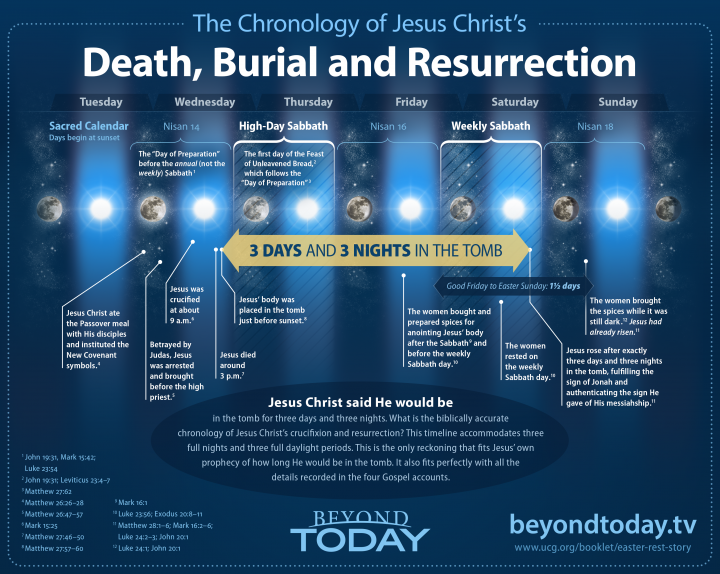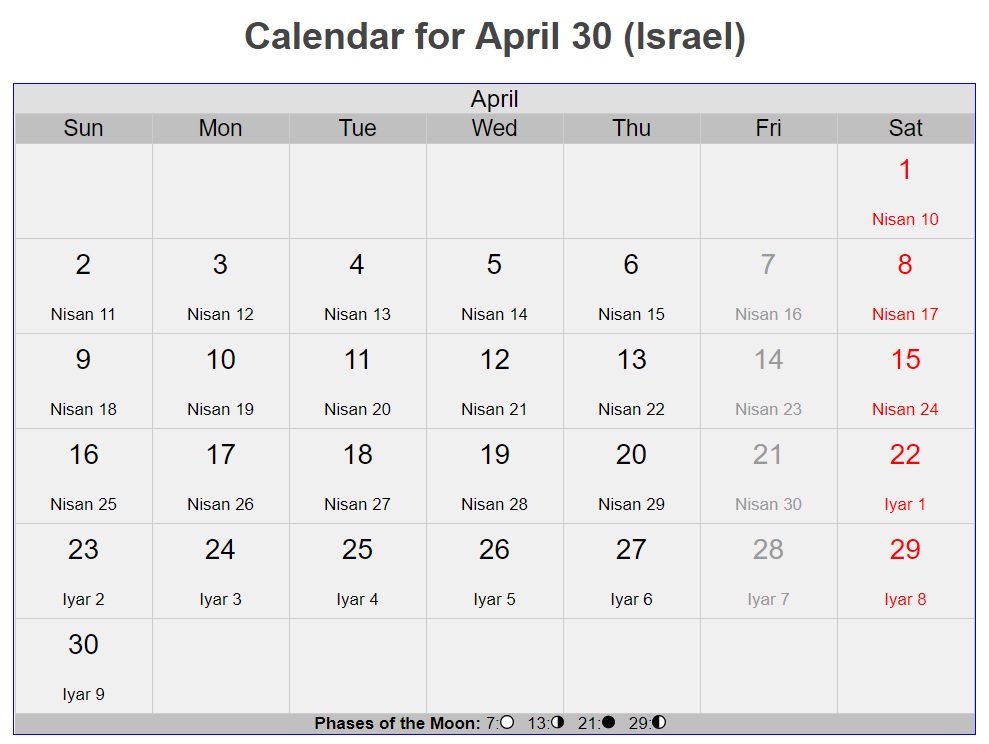 />
/>
Ralph Yost, Nov 14, 2019
Most Christian churches celebrate the resurrection of Christ on Sunday. They believe this is the day he was resurrected. Similarly, these same churches also refer to Holy Friday as the day Christ was crucified.
Many believers do not understand the correct chronology of Christ’s crucifixion because they are not familiar with the Jewish holidays and the laws concerning how and when they are to be celebrated.
Matthew 12:40 clearly tells us that Christ would be buried for three days and three nights: "for just as Jonah was three days and three nights in the belly of the sea monster, so will the Son of Man be three days and three nights in the heart of the earth." The prophesy in Matt 12:40 cannot be fulfilled by a Christ crucifixion on Fri and resurrection before dawn of Sunday (as per John 20:1). Additional support for a 3-day burial comes from Jesus in Matt 16:
Matt 16:21: “From that time Jesus began to show His disciples that He must go to Jerusalem, and suffer many things from the elders and chief priests and scribes, and be killed, and be raised up on the third day.”
Here, the Greek word for “third” is τρίτῃ (tritē) which is derived from τρεῖς (treis) which means three.
Then we have the words of the chief priests and the Pharisees who likewise recognized the 3-day burial:
Matt 27:62-63: “Now on the next day, the day after the preparation, the chief priests and the Pharisees gathered together with Pilate, 63 and said, “Sir, we remember that when He was still alive that deceiver said, ‘After three days I am to rise again.’”
Here again, τρεῖς (treis) was used by Matthew for “three.”
Early in the gospel of John, Jesus tells the Jews at the temple -
John 2:19-22: "Jesus answered them, “Destroy this temple, and in three days I will raise it up.” 20 The Jews then said, “It took forty-six years to build this temple, and will You raise it up in three days?” 21 But He was speaking of the temple of His body. 22 So when He was raised from the dead, His disciples remembered that He said this; and they believed the Scripture and the word which Jesus had spoken."
The Greek word used by John for “three” is τρισὶν (trisin) which is derived from τρεῖς (treis).
Starting on Friday afternoon, then adding 3 days and 3 nights, leads you to Monday evening. In this schema, Christ would have to have been resurrected on Monday evening.
The challenge before us today is to reconcile the Jewish religious holiday calendar with our modern day of the week calendar. The Jewish religious holiday calendar is not anchored by day of the week terminology as the modern church uses for a reference (i.e. Resurrection Sunday, or Easter, Good Friday, etc). In this position paper, we will attempt to overlay each in order to accomplish this reconciliation.
We will see that during the week of Christ’s crucifixion there were three holy holidays, one of which included a Sabbath day:
At the end of the week is the regular Saturday Sabbath day of rest. In modern day, both Passover and Feast of Unleavened bread are combined into one holiday which is summarized as “the eight days of Passover” as we read in Luke 22:1:” Now the Feast of Unleavened Bread, which is called the Passover, was approaching.” and also in verse 7: “Then came the first day of Unleavened Bread on which the Passover lamb had to be sacrificed.”
Passover is a one-day holiday observed on the 14th of Nisan every year (Nisan is considered the first month, although it occurs March thru April in the Roman calendar.) –
Leviticus 23:5: “In the first month, on the fourteenth day of the month at twilight is the Lord’s Passover.” (also Exodus 12:6; Num 9:3; 28:16)
The Feast of Unleavened Bread lasts for seven days and begins on the 15th day of Nisan. Each day of the feast, sacrifices had to be offered up in the temple:
Lev 23:8: "But for seven days you shall present an offering by fire to the Lord. On the seventh day is a holy convocation; you shall not do any laborious work.’”
No work was allowed to be performed on the first and seventh day of the Feast of Unleavened Bread (Ex 12:16; LEV 23:7-8; Dt. 16:8). Leaven was also prohibited.
The Feast of First Fruits is observed on the 16th day of Nisan. The bible does not specify the actual calendar date for the celebration of the Feast of First Fruits. Lev 23:10-11 instructs that it be done “on the day after the Sabbath.” The Jews, including the Pharisees, interpreted this to be the Sabbath that occurred on Nisan 15 on which no work was to be performed. Josephus writes “But on the second day of unleavened bread, which is the sixteenth day of the month, they first partake of the fruits of the earth, for before that day they do not touch them. (3.10.5, Antiquities of the Jews). One of the sacrifices required was an unblemished male lamb of the first year.
There are TWO Sabbath days in this week – first an annual Holy Day and then the regular weekly Sabbath – which are mentioned in the Gospels. Mark describes it (see also Luke 22:1-15).
Mark 14:1-2: "Now the Passover and Unleavened Bread were two days away; and the chief priests and the scribes were seeking how to seize Him by stealth and kill Him; 2 for they were saying, “Not during the festival, otherwise there might be a riot of the people.”"
Matthew, Mark, and Luke all mention “the first day of Unleavened Bread” as the day they prepared the upper room. That evening Jesus and the disciples have the Passover meal:
Matt 26:17: "Now on the first day of Unleavened Bread the disciples came to Jesus and asked, “Where do You want us to prepare for You to eat the Passover?”"
Mark 14:12: "On the first day of Unleavened Bread, when the Passover lamb was being sacrificed, His disciples said to Him, “Where do You want us to go and prepare for You to eat the Passover?”"
Luke 23:7-8: "Then came the first day of Unleavened Bread on which the Passover lamb had to be sacrificed. 8 And Jesus sent Peter and John, saying, “Go and prepare the Passover for us, so that we may eat it.”"
Below is a calendar of 30 A.D. that incorporates the Jewish month of Nisan in order to align the days of Nisan with the days of the week:
< />
/>
This calendar depicts when the daytime hours of each day of Nisan occur. Note that the day of Nisan noted actually began at sundown on the previous calendar day!! This is crucial to understanding the chronology of Christ’s crucifixion.
The following chronology explanation describes the events leading up to and including the exact day of Christ’s crucifixion and subsequent resurrection:
TUESDAY Nisan 13
The 13th day (Tuesday) of Nisan is called the preparation day for the Passover. The Passover meal is eaten after 6:00pm, which means that it is really eaten on the 14th day of Nissan.
In Mark 14, we read about the preparation for the yearly Sabbath Passover made by the disciples:
Mark 14:12-17: On the first day of Unleavened Bread, when the Passover lamb was being sacrificed, His disciples said to Him, “Where do You want us to go and prepare for You to eat the Passover?” 13 And He sent two of His disciples and said to them, “Go into the city, and a man will meet you carrying a pitcher of water; follow him; 14 and wherever he enters, say to the owner of the house, ‘The Teacher says, “Where is My guest room in which I may eat the Passover with My disciples?”’ 15 And he himself will show you a large upper room furnished and ready; prepare for us there.” 16 The disciples went out and came to the city, and found it just as He had told them; and they prepared the Passover. 17 When it was evening He came with the twelve.
Jesus and his disciples leave Bethany and walk to Jerusalem. Two of his disciples (John and Pater) were sent ahead of the rest in order to find a place for them to have the meal and make the appropriate preparations.
Remember that Jewish days are calculated from sunset-to-sunset, not midnight-to-midnight. Six times in Genesis 1, the Lord referred to the day as “the evening and the morning” (Gen 1:5, 8, 13, 19, 23, 31).
Tuesday evening (at the beginning of Nisan 14):
The Passover lamb to be eaten at the dinner had to be killed in the evening of Nisan 14. It is the first thing done when Nisan 14 begins:
Exodus 12: 6: “You shall keep it until the fourteenth day of the same month, then the whole assembly of the congregation of Israel is to kill it at twilight.”
The word “twilight” is from the Hebrew word הָעַרְבָּֽיִם׃ (hā·‘ar·bā·yim) which means “evening”. The lamb is killed at the beginning of the 14th day of Nisan (in the evening hours between sundown and dark). The Passover dinner then follows at the early part of the 14th part of Nissan but is in the evening (dark) hours.
Jesus and the disciples eat the Passover dinner at nightfall. (Matt.26:17-19; Luke 22:13-20)
Matthew tells us that Jesus institutes a new covenant at this dinner:
Matt 26:26-28: “While they were eating, Jesus took some bread, and after a blessing, He broke it and gave it to the disciples, and said, “Take, eat; this is My body.” 27 And when He had taken a cup and given thanks, He gave it to them, saying, “Drink from it, all of you; 28 for this is My blood of the covenant, which is poured out for many for forgiveness of sins.”
At the conclusion of the dinner, they walk to the Mt. of Olives.
Still Nisan 14, during the night, on the Mt. of Olives, Jesus is betrayed by Judas in the Garden of Gethsemane. He is arrested, then he is brought before Caiaphas that night. The trial of Jesus concludes at daybreak (when the rooster crows three times). It is now Wednesday but still Nissan 14 at day break.
WEDNESDAY – Nisan 14
The 14th day of Nisan began Tuesday evening and runs into the daylight hours of Wednesday until Wednesday evening. The 14th day (Wednesday) of Nissan was called the first day of the Passover and people still worked on this day.
Jesus is brought to Pilate at 6:00am (Matt.27:1-2)
Matt 27:1-2: “Now when morning came, all the chief priests and the elders of the people conferred together against Jesus to put Him to death; 2 and they bound Him, and led Him away and delivered Him to Pilate the governor.”
Mark 15:1: "Early in the morning the chief priests with the elders and scribes and the whole Council, immediately held a consultation; and binding Jesus, they led Him away and delivered Him to Pilate."
Jesus is beaten, drags his cross to Golgatha, then is crucified. Jesus was crucified at about the 3rd hour (9:00a.m.).
Mark 15:25: "It was the third hour when they crucified Him."
He dies “about the ninth hour” (which is nine hours after six in the morning or equal to 3:00pm):
Matt 27:46-50: “About the ninth hour Jesus cried out with a loud voice, saying, “Eli, Eli, lama sabachthani?” that is, “My God, My God, why have You forsaken Me?” 47 And some of those who were standing there, when they heard it, began saying, “This man is calling for Elijah.” 48 Immediately one of them ran, and taking a sponge, he filled it with sour wine and put it on a reed, and gave Him a drink. 49 But the rest of them said, “Let us see whether Elijah will come to save Him.” 50 And Jesus cried out again with a loud voice, and yielded up His spirit.”
Matthew tells us of the women who observed His death:
Matt 27:55-56: "Many women were there looking on from a distance, who had followed Jesus from Galilee while ministering to Him. 56 Among them was Mary Magdalene, and Mary the mother of James and Joseph, and the mother of the sons of Zebedee."
These woman will later be referred to in order to help us see how two Sabbaths were in the same week but separated by a single day.
The Gospel of John says of the day beginning following Christ's death, "that Sabbath day was a high day" (19:31–42). This would be referring to Nisan 15 which would begin at sundown on Wednesday.
John 19:31: “Then the Jews, because it was the day of preparation, so that the bodies would not remain on the cross on the Sabbath (for that Sabbath was a high day), asked Pilate that their legs might be broken, and that they might be taken away.”
This was the preparation for the ANNUAL Sabbath day, not the weekly Sabbath! This holiday begins at sunset.
John 19:42: “Therefore because of the Jewish day of preparation, since the tomb was nearby, they laid Jesus there.”
We have now clearly established that Jesus died on the day before The Sabbath day of the Feast of Unleavened Bread.
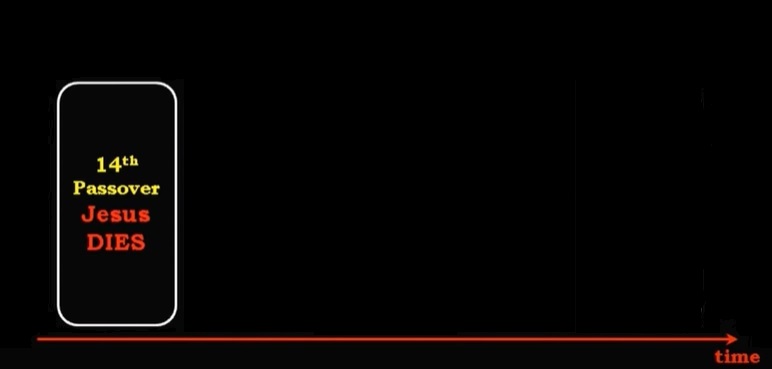
THURSDAY Nisan 15 – The Sabbath day of the Feast of Unleavened Bread
Wednesday evening after sundown was the start of Nisan 15 (Wednesday night and into Thursday daylight hours), just after the first day of Passover week (Unleavened Bread) and an annual miqra and rest day, in most chronologies. The 15th day (Thursday daylight hours) of Nissan was the Feast of the Unleavened Bread and also known as the high Sabbath.
No work could be done by Jews on the high Sabbath holy day. Therefore Jesus had to be buried before sundown on Wednesday.
The whole area had to be cleaned the day before the high Sabbath day. Roads leading into Jerusalem were cleaned of any garbage. Dead animals were removed. Even tombs were white washed.
Lev 23:7: "On the first day you shall have a holy convocation; you shall not do any laborious work."
The high Sabbath ends in the evening of Thursday Nisan 15.
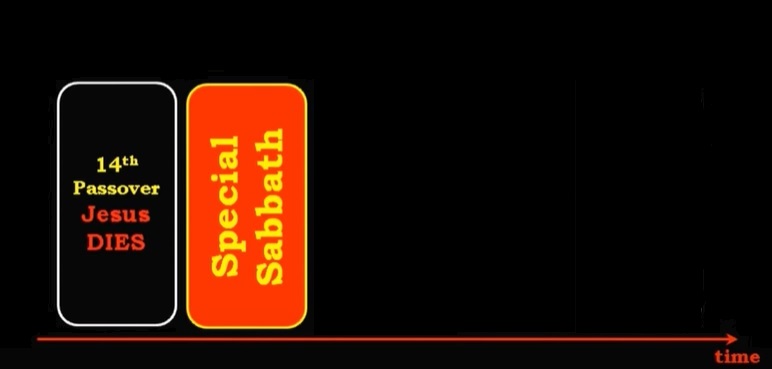
FRIDAY 16th Day of Nisan
Friday is the 16th day of Nissan. It was called “The Morrow After” the Sabbath. This was the day of the cutting of barley sheaves. The 16th day of Nisan began Thursday evening and runs into the daylight hours of Friday until Friday evening.
Mark tells us that the women bought spices when this Feast of Unleavened Bread Sabbath was over. This would be referring to daylight hours of Friday 16th day of Nisan -
Mark 16:1: "When the Sabbath was over, Mary Magdalene, and Mary the mother of James, and Salome, bought spices, so that they might come and anoint Him."
Luke tells us that the women had watched to see where Jesus was buried on Wednesday, then later on Friday returned to prepare the spices and perfumes. Note that Luke does not use any time references except that after preparing the spices, then rested “on the Sabbath.”:
Luke 23:55-56: "Now the women who had come with Him out of Galilee followed, and saw the tomb and how His body was laid. 56 Then they returned and prepared spices and perfumes. And on the Sabbath they rested according to the commandment. "
These are the same women who were mentioned in Matt 27:55-56. They had observed Him on the cross. But Luke is referring to the regularly weekly, Saturday Sabbath.
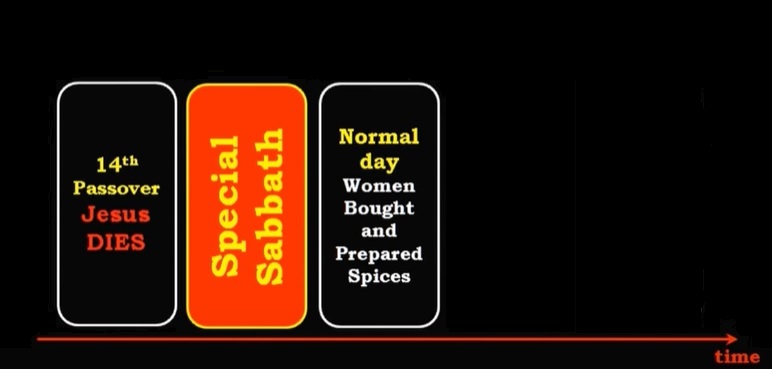
SATURDAY the 17th Day of Nisan
Saturday is a regularly weekly Sabbath – the 17th day of Nisan. The 17th day of Nisan began Friday evening and runs into the daylight hours of Saturday until Saturday evening
Before sundown on Saturday, Jesus has now been in the grave 72 hours (3 days) which included Wedneday night, Thur night, and Fri night – 3 nights. He is resurrected exactly 72 hours after he was buried.
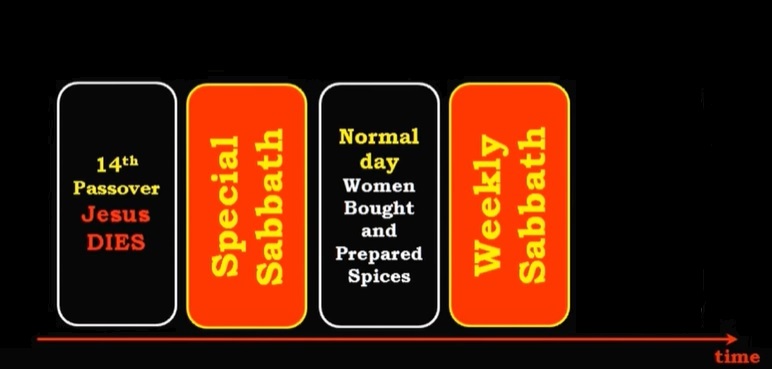
SUNDAY the 18th day of Nissan
The 18th day of Nisan began Saturday evening and runs into the daylight hours of Sunday until Sunday evening.
John tells us that Mary ran to the tomb very early in the morning on Sunday, the 18th day of Nisan.
John 20:1: “Now on the first day of the week Mary Magdalene came early to the tomb, while it was still dark, and saw the stone already taken away from the tomb.”
Matthew tells us that both Mary’s came to the grave on the first day of the week after the Sabbath :
Matt 28:1: "Now after the Sabbath, as it began to dawn toward the first day of the week, Mary Magdalene and the other Mary came to look at the grave."
The angel of the Lord told the women at the grave “He is not here, for He has risen, just as He said.” (Matt 28:6).
We now know that before Sunday morning, Jesus was resurrected from the grave. He most likely rose just before sundown on Saturday to fulfill the sign of Jonah.
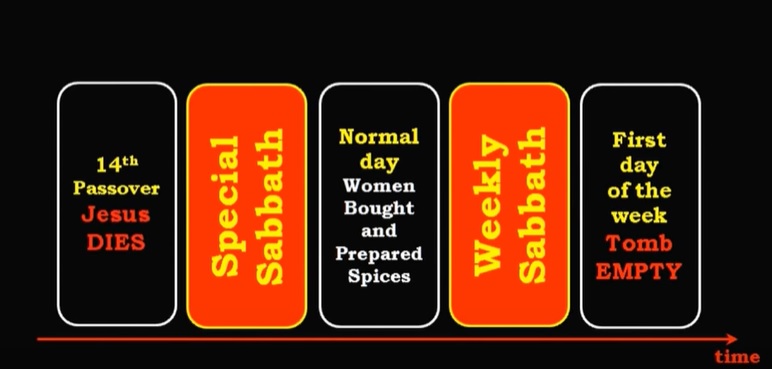
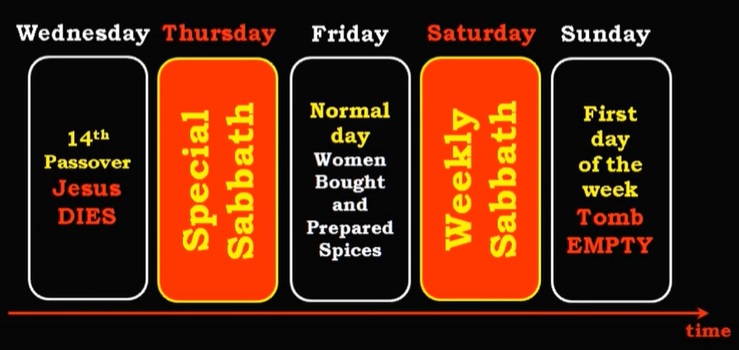
Additionally, there is scholarly debate about exactly which year Christ was crucified. Most agree it was sometime between 30 A.D. and 33 A.D.
It turns out that only 30 A.D. has the proper alignment with 14 Nisan on Wednesday. The other years do not align with the days of the week properly and the presence of the weekly Sabbath violates any attempt to lay the chronology of Christ in those years. Many have tried to use lunar events, historical records and other non-biblical sources. The solution is found in the scriptures with no need to look elsewhere.
The chart below, found on an Internet web site, clearly shows the chronology in graphic form and includes the night and day of the Jewish calendar.
